
http://www.iaeme.com/IJM/index.as 31 editor@iaeme.com
International Journal of Management (IJM)
Volume 8, Issue 4, July– August 2017, pp.31–39, Article ID: IJM_08_04_005
Available online at
http://www.iaeme.com/ijm/issues.asp?JType=IJM&VType=8&IType=4
Journal Impact Factor (2016): 8.1920 (Calculated by GISI) www.jifactor.com
ISSN Print: 0976-6502 and ISSN Online: 0976-6510
© IAEME Publication
WOMEN ENTREPRENEURSHIP: GENESIS FOR
SUCCESSFUL BUSINESS MODEL
Neeti Hooda
Research Scholar, Department of commerce, MDU, Rohtak
ABSTRACT
Age is neither a limit nor an exception to realise the true potential or the way an
individual want to live a successful life. An entrepreneur is the person who undertakes
a venture, organises it, raises capital to finance it and assumes all or major portion of
the risk. Gifford Pinchot III, an American expert on management, wrote his famous book
Intrapreneuring in 1985. He used the term ‘Intrapreneur’ to refer to the person who as
the senior manager functions like an entrepreneur within his company. He serves as the
head of a semi-autonomous product division. Though there is no major difference
between entrepreneur and intrapreneur but they differ with regard to their personality
and functions such as an entrepreneur is an independent business person and he himself
raises the required capital and undertakes the risk where as an intrapreneur operates
within a given company and thus may not be required to raise capital or to bear full
risk of his efforts within the company.
Women entrepreneurship has gained momentum in recent decades with the increase
in the number of women’s enterprises and their substantive contribution to economic
growth. In today’s dynamic era, women entrepreneurs are considered as one of the most
important global giant for sustained economic development and social progress. The
present paper provides a detail overview regarding the concept of women
entrepreneurship, what are the factors that support them to start a business, what are
the reasons that impede their growth and finally government strategies to promote these
women entrepreneurs. A survey has been made from the women entrepreneurs working
in Bahadurgarh city and finally brief analysis and interpretation are done on the basis
of collected data in the form of bar graphs, pie charts, and column charts etc.
Key words: Entrepreneurship, Business, Risk, Government-Strategies.
Cite this Article: Neeti Hooda, Women Entrepreneurship: Genesis For Successful
Business Model. International Journal of Management, 8 (4), 2017, pp. 31–39.
http://www.iaeme.com/ijm/issues.asp?JType=IJM&VType=8&IType=4

Women Entrepreneurship: Genesis For Successful Business Model
http://www.iaeme.com/IJM/index.as 32 editor@iaeme.com
1. INTRODUCTION
Entrepreneurship is the process of identifying opportunities in the market place marshalling the
resources required to pursue these opportunities and investing the resources to exploit the
opportunities for long term benefits. Entrepreneurial activity stems from an imbalance between
the potentiality of something new and its realization – particularly creating an exploited
opportunity where none existed previously by one or more individuals. Entrepreneurship may
operate within an entrepreneurship eco-system which includes Government programs and
services that promote entrepreneurs , entrepreneurship resources(e.g. business incubators and
seed accelerators), entrepreneurship education , training , and financing (e.g. loans, venture
capital financing and grants.)
Over the past decade, entrepreneurship domain has been considered as vital aspect in the
areas of corporate entrepreneurship, macro environment linkages, International linkages and
career alternatives. Entrepreneurial activity is not similar in all the countries, regions, and cities.
Entrepreneurship is conditioned by various factors settled in the behaviour motivations and
knowledge of the individual and thus which in turn depends on the conditions prevailing in the
environment.
Women play an important role in the family which is the basic unit of the society. There
was a time when women had to remain in the four walls of the house. Neither she gets support
from their family nor from society. But now time has changed women is seen in every field
from home oriented to job oriented life. Empowerment of women is therefore an important
approach opted during the Tenth Five Year Plan (2002-07). Two important schemes that is
Saarva Shiksha Abhiyan and Mahila Samakhaya are being implemented by department of
education in order to promote education among girl child.
BASIC IDEA OF WOMEN ENTREPRENEUR
Women entrepreneur may be defined as a woman or a group of women, who initiate, organise
and run a business enterprise. Government of India defined women entrepreneurs as “owing
and controlling an enterprise with a women having a minimum financial interest of 51% of the
capital and giving at least 51% of the employment generated in the enterprise to women.” A
recent Global Entrepreneurialism Report conducted by international Bank PNB Paribas has
ranked India on the top of the highest percentage of woman entrepreneurs. The survey found
that 49% of the entrepreneurs in India are women.
2. LITERATURE REVIEW
Several studies have been made in India and abroad on specific aspects in the field of
entrepreneurship. Some prominent work done in this regard will be summarized as:
Beena and Sushma (2003) and Krishnaveni Motha (2004) provide some motivational factors
that affect women entrepreneurship in India. Some of them were as: economic needs, support
by families and friends, adequate education and training, easy availability of finance, family
occupation etc.
Poornima M Charantimath ( 2005) in her book titled Entrepreneurship Development Small
Business Enterprises suggested that entrepreneurs are the one who plant the seeds of industrial
development which bear fruit in the form of increased employment opportunities, increase in
per capita income, increased individual savings, as well as generate additional revenue for
government in the form of taxes and export-import duties.
Thomas W. Zimmerer and Norman M. Scarborough(2006) in their book Essentials of
Entrepreneurship and Small Business Management defines entrepreneurs as a person who
creates a new business in the face of risk and uncertainty for the purpose of achieving profit

Neeti Hooda
http://www.iaeme.com/IJM/index.as 33 editor@iaeme.com
and growth by identifying significant opportunities and assembling the necessary resources to
capitalize on them.
Chotkan, (2009) suggests that there are different socio-economic factors such as age, work
status, education, income, social ties and perceptions are significant to start a new venture.
L. Suresh Malaya (2011) in his study describes the case study in terms of achievements of fifty
entrepreneurs of Indian origin. The study focuses on the traits that would be found in an
effective and successful entrepreneur such as risk taking capacity, self-confidence, tolerance of
ambiguity, creative, optimism, persuasiveness, courage etc.
Priyanka Sharma (Global Journal of Management and Business Studies-ISSN2248-9878 Vol
3-2013) in her research paper Women Entrepreneurship Development in India stresses the
involvement of women in the field of economic activities. Overall conclusion of the research is
that today women are more willing to take up activities that were once considered only for men
and therefore they are becoming more competent enough to strive for excellence in an
entrepreneurial arena.
Department of scientific and Industrial Research ( August 2007) in their study focused on
the performance of and status of technology intensive star-up’s in selected areas and evolve
measures to encourage and support start-up businesses. The study of the paper is limited to
following areas such as: defence equipments and accessories, plastic and machinery parts, auto
components, dyes and chemicals and drugs and pharmaceutical intermediates. Overall
conclusion of the research is that most of the promoters (74%) are simple graduates followed
by 20% engineers, 4% diplomas and ITI certificate holders and only few have professional
qualifications. Very few have tie-ups with either university or technical labs.
3. PROBLEMS FACED BY WOMEN-ENTREPRENEURS IN INDIA.
3.1 Lack of confidence: Most of the women lack confidence before doing any start because
they don’t get enough of support from their family members and society there to. But to a certain
extent, there is now a paradigm shift among Indian women and that’s why they now have the
capacity to start a new venture with confidence.
3.2 Socio-cultural barriers: There are only few women who can manage both home and
business efficiently. Sometimes society too poses a challenge for women.
3.3 Market-oriented risks: Many business women are unable to make full coverage of the
market area due to lack of mobility and stiff competition in the current market trends.
3.4 Lack of business awareness: Some people can have cash injunction of some sort but they
don’t possess that capability and skills that is required to start a new business. Thus a proper
knowledge of business administration among women entrepreneurs would help them to make
a good decision and thereby help in developing a good business network.
3.5 Problem of finance: Most of the institutions extend maximum support to these start ups
but the major problem they face is the problem of finance. In order to overcome such issue
nowadays government of India is keen to support these women entrepreneurs both in rural and
urban areas by starting different schemes.
3.6 Problem of identification of available resources: women are hesitant to find out the
access to cater their needs in the financial and marketing areas. Despite of the government
support some women entrepreneurs are not able to identify and marshal all the resources in the
form of revenues, asset mankind.

Women Entrepreneurship: Genesis For Successful Business Model
http://www.iaeme.com/IJM/index.as 34 editor@iaeme.com
4. FACTORS THAT NECESSITATE THE WOMEN TO TAKE UP
EMPLOYMENT
5. OBJECTIVES OF THE STUDY
• A little survey to have a detailed analysis of entrepreneurs of Bahadurgarh city.
• To know the factors that facilitates women to start a business.
• To have an insight about the challenges being faced by them.
• To gain an insight into government strategies in order to boost these starts ups.
6. RESEARCH METHODOLOGY
The methodology that is adopted to carry out research consists of primary as well as secondary
data.
6.1 RESEARCH TYPE: DESCRIPTIVE RESEARCH
6.2 SAMPLING TECHNIQUES: STRATIFIED SAMPLING
6.3 SAMPLE SIZE: 60
6.4 DATA COLLECTION: Data is collected through primary as well as secondary sources.
Primary data is collected in the form of Questionnaire survey method. Secondary data is
collected from various references as mentioned below. Target population selected comprises of
urban women entrepreneurs. The study is undertaken by using stratified sampling in which
population strata is divided according to gender, age, occupation. For the collection of data,
Questionnaire was designed keeping in mind the objective of research.
Factors
push factors
sudden fall in
family income.
permanent
inadequacy in
income of family.
pull factors
women;s desire to
evaluate their
talent.
Time utilization.
To gain
recognition and
social status.
To Have economic
freedom.

Neeti Hooda
http://www.iaeme.com/IJM/index.as 35 editor@iaeme.com
7. DATA ANALYSIS AND INTERPRETATION:
VARIABLES
GENDER:
Female
AGE:
20-24
24-28
28-32
32-36
36-40
PERCENTAGE
100
10
40
30
13.34
6.66
Question no 1. Is this your first business?
Yes
No
90
10
Question no 2. What are the reasons for starting your business?
•
Profit earning
• Social-status
• Self-achievement
• Did not want to work for others
• Self-confidence
26.67
16.67
26.67
23.33
6.66





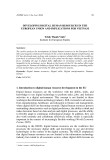
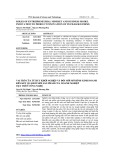
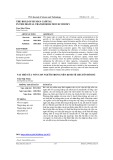
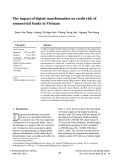
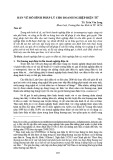
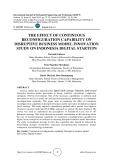

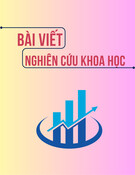










![Bộ câu hỏi trắc nghiệm Đổi mới và sáng tạo [mới nhất]](https://cdn.tailieu.vn/images/document/thumbnail/2025/20251007/kimphuong1001/135x160/56111759828894.jpg)


